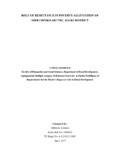Please use this identifier to cite or link to this item:
https://elibrary.tucl.edu.np/handle/123456789/2331| Title: | Role of Remittance In Poverty Alleviation of Dhikurpokhari Vdc, Kaski District |
| Authors: | Dahal, Nirmal |
| Keywords: | Remittance;Poverty alleviation |
| Issue Date: | 2017 |
| Publisher: | Central Department of Rural Development Tribhuvan University, Kathmandu |
| Abstract: | This Study entitled ROLE OF REMITTANCE IN POVERTY ALLEVIATION OF DHIKURPOKHARI VDC, KASKI DISTRICT was conducted with the objectives of describing the present socio-economic status, finding socio-cultural, economic and other impact of remittance to the households and assess the evolving practices on remittance in Dhikurpohkari VDC of Kaski District. This study is mainly based in the primary information and the data were collected using the techniques of household survey, focus group discussion and the personal interview with the help of questionnaire and KII interview. There were 1880 households (HHs) in the VDC. Of the total households, 60 households that are/were receiving remittance money for a period of 2 years or more were selected as the sample for the study. During the study it was found that Brahmans (50%) were the main ethnic group selected as sample households. Agriculture (93.33%) was the main occupation, Average family size is 5-6 and Dubai and Malaysia are the main destination country in the study area. Most of the male (96.67%) and very few female (3.33%) are gone for foreign employment. Most of the people were gone for foreign employment due to unemployment (50%), Brahman are highly paid ethnic group above 400000 for their work in foreign country from study area. About 66.67% people take loan to go to foreign country; around 40% people receive money through banking system mostly in the month of Asoj to Mangsir (66.67%) during festivals like Dashain and Tihar. Income status is high for Brahman, some of they can earn more than 60000 in a month. About 30% of the people of study area work in construction side and average duration of stay of foreign employee is 4 years. 30% of people are unable to save money. About 43.33% people use their remittance in business. The number of children in private school, college is increased after receiving remittance. Treatment of diseases with Dhami/Jhakri is decreased after receiving remittance and indebtedness is decreased. 100% people have access in healthy/nutrient food after receiving remittance from the study area and about 30% people are investing in productive sector. From the study we can conclude that all the households who are/were receiving remittance are getting benefit. Their access to health, education and economy has increased. By the use of remittance income, there has been investment in the income generating activities resulting in the regular flow of money in the households and motivation for entrepreneurship development at local level has helped positively in reduction of poverty and in holistic development of rural areas. All households were very positive towards remittance income. They suggested that focus should be in easy availability of loan facilities at low price and providing skills and trainings before going as migrant labor |
| URI: | http://elibrary.tucl.edu.np/handle/123456789/2331 |
| Appears in Collections: | Rural Development |
Items in DSpace are protected by copyright, with all rights reserved, unless otherwise indicated.

